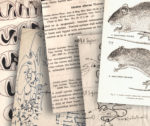Patrones biogeográficos de los murciélagos de Argentina: riqueza de especies y congruencia distribucional
María L. Sandoval Salinas, M. Mónica Díaz, Ignacio Ferro, Rubén M. BarquezEn la actualidad se conocen 67 especies de murciélagos para Argentina. A pesar de que los registros geográficos de las especies están bien documentados, sus patrones distribucionales a escala nacional no han sido estudiados hasta el momento. En este trabajo analizamos la totalidad de los registros validados, con el fin de identificar patrones de riqueza de especies y congruencia distribucional. La mayor riqueza específica se concentra en la Selva Paranaense y en las Yungas, y se observa una marcada caída de riqueza en el gradiente latitudinal. La coincidencia de los rangos geográficos de las especies define un total de 47 áreas de congruencia distribucional consenso, y cada una fue asignada a uno de los ocho patrones identificados: las Yungas, el sector norte de las Yungas (anidado con el anterior), el noreste, un patrón disyunto que incluye el noroeste y el noreste del país, la región chaqueña unida a otras regiones circundantes, y la región patagónica. Cincuenta y una especies (76% del total) resultaron caracterizadoras. Varios de los patrones encontrados son coincidentes con áreas recuperadas para otros organismos (vegetales y animales), aspecto que podría sugerir la existencia de áreas con historias comunes para gran parte de la biota de la región.
Biogeographic patterns of the bats of Argentina: species richness and distributional congruence. Currently 67 species of bats are recognized for the fauna of Argentina. Notwithstanding the geographical records of the species are well documented, their distributional patterns on a national scale have not been studied so far. In this study, we analyze all the validated records, in order to identify patterns of species richness and distributional congruence. The highest species richness was located in the Paraná forest (northeast) and the Yungas forest (northwest), with a marked drop in richness in the latitudinal gradient. The coincidence of the geographical ranges of the species defined a total of 47 consensus areas of distributional congruence, and each one was assigned to one of eight identified patterns: the Yungas, the northern sector of the Yungas (nested with the previous one), the northeast, a disjunct pattern that includes the northwest and northeast of the country, the Chaco region along with other surrounding regions, and the Patagonian region. Fifty-one species (76% of the total) were characterizers. Several of the patterns found coincide with areas recovered for other organisms (plants and animals), which could suggest the existence of areas with common histories for much of the biota of the region.
